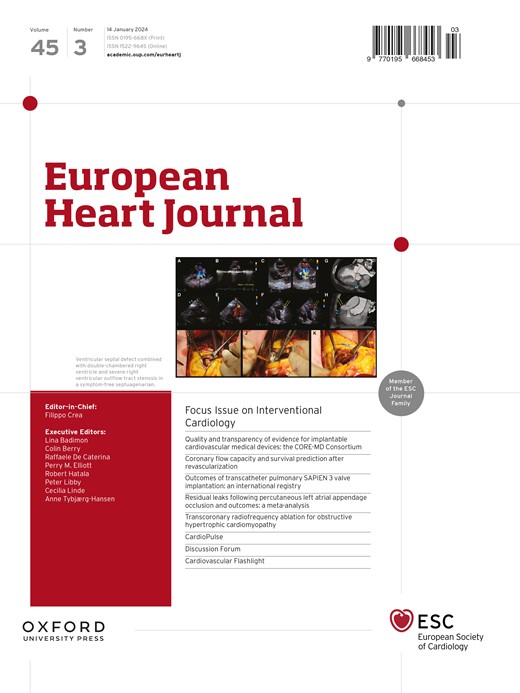Refractory angina: mechanisms and stratified treatment in obstructive and non-obstructive chronic myocardial ischaemic syndromes
IF 37.6
1区 医学
Q1 CARDIAC & CARDIOVASCULAR SYSTEMS
引用次数: 0
Abstract
The diagnosis of refractory angina has conventionally been limited to patients with angina and ischaemia secondary to obstructive atherosclerotic epicardial coronary disease who experience persistent symptoms despite optimal pharmacological and revascularization therapies. It is now well-established that angina may also be caused by ischaemia resulting from coronary microcirculatory disorders, coronary vasospasm, and bridging in the absence of obstructive epicardial coronary disease or after “successful” revascularization. This increasingly prevalent and symptomatic group of patients, with both angina and demonstrable ischaemia, have been excluded from the conventional definition of refractory angina. In patients with obstructive epicardial coronary disease, disturbed microcirculatory and vasomotor function, amongst other ischaemic mechanisms, may account for continuing symptoms despite revascularization. Under-recognition of these mechanisms results in inadequate treatment and symptom persistence. In this review, a redefinition of refractory angina is proposed to include the full spectrum of patients experiencing persistent angina despite current maximal guideline-directed medical and revascularization therapies. Systematic approaches for comprehensive investigation are suggested to identify underlying mechanisms of ischaemia and stratify treatments accordingly. The complex needs of patients with refractory angina are likely best addressed by an inter-disciplinary Angina Heart Team with the aim of improving patient symptoms, quality of life, and clinical outcomes.难治性心绞痛:梗阻性和非梗阻性慢性心肌缺血综合征的机制和分层治疗
难治性心绞痛的诊断传统上仅限于继发于阻塞性动脉粥样硬化性心外膜冠状动脉疾病的心绞痛和缺血患者,尽管采用了最佳的药物和血运重建治疗,但这些患者的症状仍持续存在。现在已经确定,心绞痛也可能是由冠状动脉微循环障碍、冠状动脉血管痉挛和无阻塞性心外膜冠状动脉疾病或“成功”血运重建后桥接引起的缺血引起的。这种越来越普遍和有症状的患者,同时伴有心绞痛和明显的缺血,已被排除在难治性心绞痛的传统定义之外。在阻塞性心外膜冠状动脉疾病患者中,微循环和血管舒缩功能紊乱,以及其他缺血机制,可能是尽管血管重建术仍持续出现症状的原因。对这些机制的认识不足导致治疗不足和症状持续存在。在这篇综述中,建议重新定义难治性心绞痛,包括所有经历持续性心绞痛的患者,尽管目前最大的指导医学和血运重建治疗。建议采用系统的方法进行全面调查,以确定缺血的潜在机制并相应地分层治疗。难治性心绞痛患者的复杂需求可能最好由一个跨学科的心绞痛心脏团队来解决,目的是改善患者的症状、生活质量和临床结果。
本文章由计算机程序翻译,如有差异,请以英文原文为准。
求助全文
约1分钟内获得全文
求助全文
来源期刊

European Heart Journal
医学-心血管系统
CiteScore
39.30
自引率
6.90%
发文量
3942
审稿时长
1 months
期刊介绍:
The European Heart Journal is a renowned international journal that focuses on cardiovascular medicine. It is published weekly and is the official journal of the European Society of Cardiology. This peer-reviewed journal is committed to publishing high-quality clinical and scientific material pertaining to all aspects of cardiovascular medicine. It covers a diverse range of topics including research findings, technical evaluations, and reviews. Moreover, the journal serves as a platform for the exchange of information and discussions on various aspects of cardiovascular medicine, including educational matters.
In addition to original papers on cardiovascular medicine and surgery, the European Heart Journal also presents reviews, clinical perspectives, ESC Guidelines, and editorial articles that highlight recent advancements in cardiology. Additionally, the journal actively encourages readers to share their thoughts and opinions through correspondence.
 求助内容:
求助内容: 应助结果提醒方式:
应助结果提醒方式:


